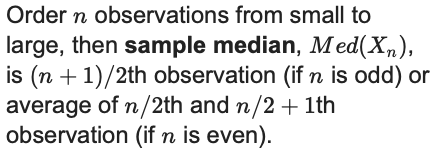
Outlier Detection (Part 1): Univariate
Last Updated on July 24, 2023 by Editorial Team
Author(s): Mishtert T
Originally published on Towards AI.

Analyze even better — For Better Informed Decision
Robust Statistics: Example in R

Making a Point
A popular tool for outlier detection is
- Calculate z-score for each observation.
- Flag observation as an outlier if z-score has an absolute value greater than 3

For Example: Let’s look at a log-transformed dataset named log_inc of the monthly income of 10 people. If you look closely, the last observation is clearly an outlier.
7.876638 7.681560 7.628518 … 7.764296 9.912943
Computing the z-score for each observation:
Mean <- mean(log_inc)
Sd <- sd(log_inc)
z_score <- abs((log_inc — Mean)/Sd)
Checking if z-scores are larger than 3 in absolute value:
abs(z_score) > 3
[1] FALSE FALSE FALSE FALSE FALSE FALSE FALSE FALSE FALSE FALSE
No outliers identified.
Using the same dataset we’re going to show that the last variable is detected as an outlier using Robust Statistics
Robust statistics
Classical statistical methods rely on (normality) assumptions, but even a single outlier can influence conclusions significantly and may lead to misleading results.
Robust statistics produce also reliable results when data contains outliers and yield automatic outlier detection tools.
“It is perfect to use both classical and robust methods routinely, and only worry when they differ enough to matter… But when they differ, you should think hard.” — J.W. Tukey (1979)
Estimators of Location of Xn:
Sample Mean

Median

Estimators of Scale:



Robust z-scores for outlier detection
We plug in the robust estimators to compute robust z-scores:

Demonstration
Let’s use the same dataset that we saw as an example in the beginning.
data <- c(7.876638, 7.681560, 7.628518,7.234543,7.465769,
7.135876, 7.895643, 7.793432, 7.764296, 9.912943)Mean <- mean(data); Sd <- sd(data); Med <- median(data); Mad <- mad(data)
Z-Score Output
> abs(z_score) > 3
[1] FALSE FALSE FALSE FALSE FALSE FALSE FALSE FALSE FALSE FALSE
Robust Z-Score Output
> abs(rob_z_score) > 3
[1] FALSE FALSE FALSE FALSE FALSE FALSE FALSE FALSE FALSE TRUE
> which(abs(rob_z_score) > 3)
[1] 10
Boxplot
One of the popular tools used to identify outliers is Tukey’s boxplot. Observations are flagged as outliers if they are outside the boxplot fence.

Let’s use an example data 0.02% of “(LOS)Length of Stay in Hospital” data and plot boxplot to understand.
library(ggplot2)ggplot(data.frame(los), aes(x = "", y = los)) + geom_boxplot(outlier.colour = "red", outlier.shape = 16, outlier.size = 3,fill = "lightblue", width = 0.5) + xlab("") + ylab("Length Of Stay (LOS)") + theme(text = element_text(size = 25))

Adjusted boxplot (Hubert and Vandervieren, 2008)
- At asymmetric distributions, boxplot may flag many regular points as outliers.
- The skewness-adjusted boxplot corrects for this by using a robust measure of skewness in determining the fence.
library(robustbase)adjbox_stats <- adjboxStats(los)$statsggplot(data.frame(los), aes(x = "", y = los)) + stat_boxplot(geom = "errorbar", width = 0.2, coef = 1.5*exp(3*mc(los))) + geom_boxplot(ymin = adjbox_stats[1],ymax = adjbox_stats[5],middle = adjbox_stats[3],upper = adjbox_stats[4],lower = adjbox_stats[2],outlier.shape = NA,fill = "lightblue",width = 0.5) +
geom_point(data=subset(data.frame(los),los < adjbox_stats[1] U+007C los > adjbox_stats[5]),col = "red", size = 3, shape = 16) +xlab("") + ylab("Length Of Stay (LOS)") +theme(text = element_text(size = 25))

Summary:
Usage of Robust Statistics enhances our detection capability of outliers than just using classical methods.
Join thousands of data leaders on the AI newsletter. Join over 80,000 subscribers and keep up to date with the latest developments in AI. From research to projects and ideas. If you are building an AI startup, an AI-related product, or a service, we invite you to consider becoming a sponsor.
Published via Towards AI
Take our 90+ lesson From Beginner to Advanced LLM Developer Certification: From choosing a project to deploying a working product this is the most comprehensive and practical LLM course out there!
Towards AI has published Building LLMs for Production—our 470+ page guide to mastering LLMs with practical projects and expert insights!

Discover Your Dream AI Career at Towards AI Jobs
Towards AI has built a jobs board tailored specifically to Machine Learning and Data Science Jobs and Skills. Our software searches for live AI jobs each hour, labels and categorises them and makes them easily searchable. Explore over 40,000 live jobs today with Towards AI Jobs!
Note: Content contains the views of the contributing authors and not Towards AI.














